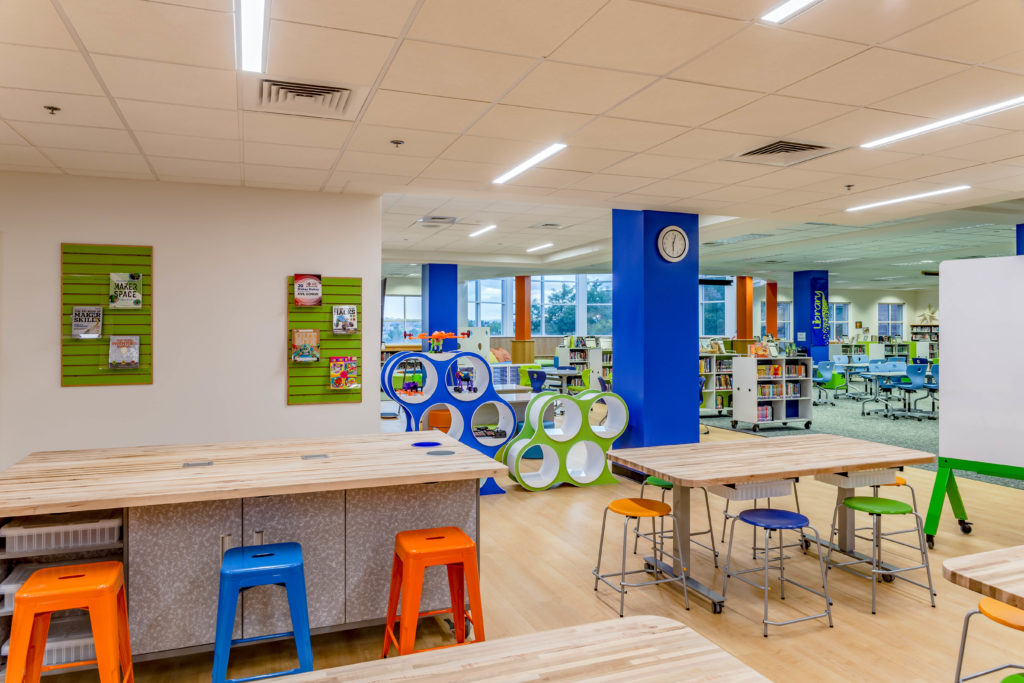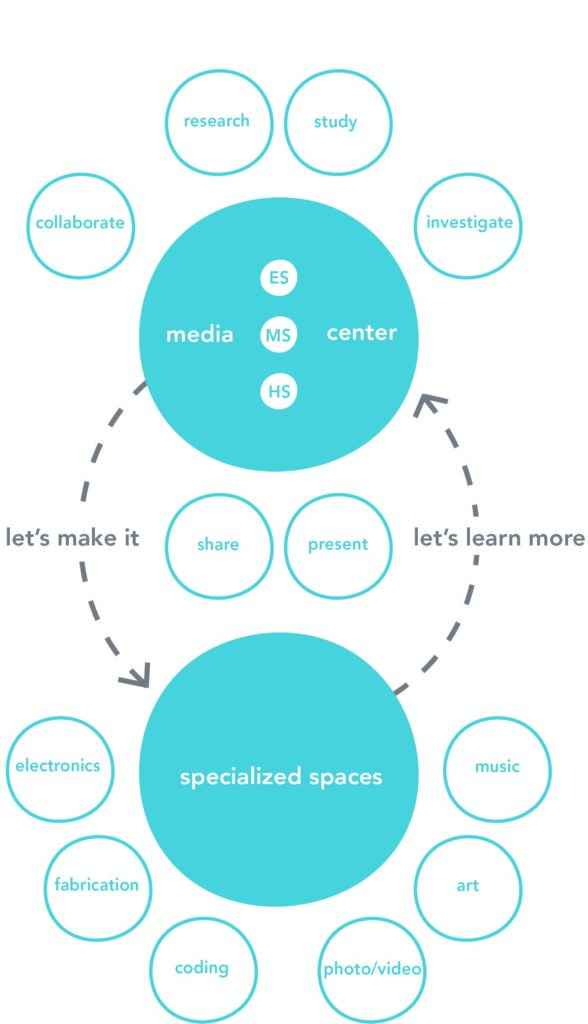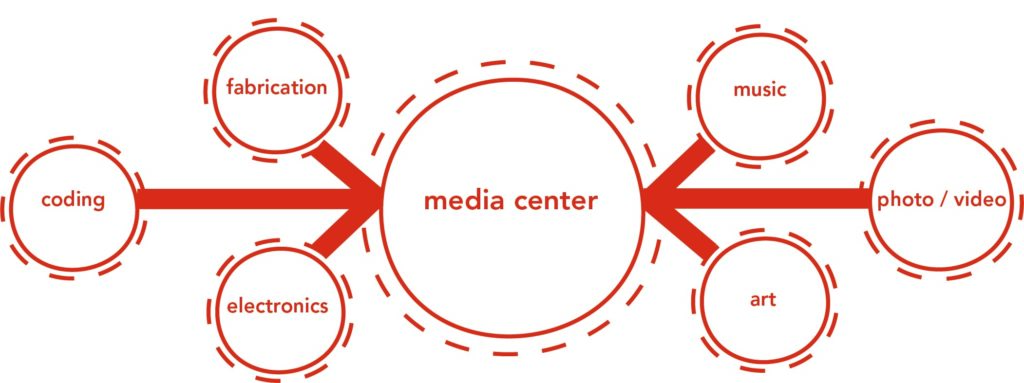Design and functionality of a school have a significant impact on the learning experience. No space offers an opportunity to incorporate modern learning styles better than the media center, already the most adaptive space in any school facility. When learning outpaces design, schools and districts face the challenge of sufficiently adapting to accommodate all students.
The traditional methods of storing, sharing and disseminating media have also shifted with the greater understanding of the learner experience. This constant metamorphosis is evidenced by the space’s many titles over time; library, IMC, media center and learning commons or instructional center.
In outdated schools, the media center design may not reflect or support these changes, in turn leading to underutilization of and lack of student engagement with the space. This presents both challenges and opportunities for schools to reconsider the role of the media center. What would it take to get your facility’s media center caught up with the dynamic needs of today’s learners?

Several key factors drive the need for changes in media centers:
- Personalized Learning
- Hands-on/Project-based learning
- Role of technology
- New forms of media
- Flexibility/future adaptability
A complete overhaul is not always feasible or the necessary option, which is why media centers offer a critical opportunity for districts to make substantive change without starting from square one.

Media at the heart of the learning experience
Media, at its most basic level, means “the system and organizations of communication through which information is spread to a large number of people.” The emergence of the internet and the prevalence of personal devices revolutionized the information sharing process for 21st century learners.
Today’s students are able to access information instantaneously wherever they go. Historically, students accessed only print media in a school’s expansive library collection and conducted research by navigating a card catalogue. A traditional library or media center was primarily dedicated to storage for book stacks and the atmosphere was quiet with individual work as the main focus.
However, education has drastically changed in the time since the school library originated. A modernized media center incorporates design elements for learning styles across the continually-growing spectrum. Educators are increasingly embracing personalized learning as a tool to unlock the capabilities of every student, allowing them to excel with their natural skills while identifying areas requiring additional support. This shift toward recognizing the unique individual needs of every student has led to a recognition that students both learn and demonstrate their learning in different ways.
This approach, in turn, necessitates a variety of spatial options to support the ever-changing needs of students. Additionally, schools demonstrate a growing trend toward experiential learning or “learning by doing” through project-based and hands-on strategies, allowing students to be active participants in their education and explore their curiosities through inquiry and exploration. Finally, technology has significantly impacted the way students collaborate, share and interact, leading to a shifting definition of what “media” is and who creates it. A result of these changes has been a dramatic paradigm shift away from the media center being “storage-centered” to being “learner-centered” and utilizing an updated prioritization of space. A modern media center goes beyond the static repository of information to a dynamic, active space that supports content creation, collaboration and personalized learning.

Trends in the leading edge media center
Reallocation of Space from Storage and Decentralization
Large physical print collections used to require sufficient, secure storage space in a library. As collections become available digitally and space liberated for new uses, less of the media center needs to be secured from the larger facility. This allows for the physical boundary of the media center to be less distinct, with many schools opting for an open “learning commons” design, sometimes dispersed throughout an entire building. This does not mean the media center has gone away; rather, educators have found space is crucial enough to the learning process that it must extend beyond the original confines.
Some schools have taken a cue from the public library system by incorporating online reservation and self-checkout as well as high-density storage solutions for print materials, since few access these materials by in-person browsing. These materials can be secured compactly without taking up valuable space, re-allocating more area to support learning activities.
Diverse Spatial Opportunities
A school’s media center serves as a central hub and houses unique resources and learning tools. Media centers can feature varied spatial options to facilitate group collaboration, brainstorming, digital media projects or individual work space.
Adaptable furniture plays a key role in this flexible design by promoting student choice and the ability to reconfigure and adapt. Diverse furniture options are crucial to support student needs on any given day.

Opportunities for Content Creation
Providing space and opportunities for students to transform learning from static consumption to interactive creation unleashes their hidden potential. An effective, modern media center supports this creative process with the use of “makerspaces” which facilitate student creation. Whether it’s 3D printing, videography, animation, podcasting or other productions, makerspaces accommodate students’ curiosities and provide them the space and tools to demonstrate comprehension and retention of these skills.
Creative, design-centric thinking is an important skill for students to develop to “learn to learn.” Incorporating makerspaces into a media center can support this type of inquiry. Students use an iterative process to define a challenge, generate ideas, make drafts, get feedback and refine their work; as a result, they learn creative problem solving.
Role of Technology
The current generation of students, as will the next generations, grew up with technology as an instrumental part of their lives. They are early adopters of new technologies and rely on a variety of digital means to learn, communicate and express themselves. As more students access information through personal devices, additional technological support and infrastructure are essential elements of a media center.
Today’s students live in a time of rapid information and knowledge exchange. Students today access a wide variety of media to enhance their learning. Students might livestream a TED Talk by a university professor, participate in a virtual field trip to a location thousands of miles away or take a webinar with peers from across the world, all from a personal hand-held device. The media center needs to provide a variety of flexible spaces to support these activities as well as those not yet discovered.
Questions to start a conversation about your school’s media center:
- What spaces are needed to support personalized and project-based learning? A “kit of parts” is the combination of the necessary types of spaces in a design concept.
- What is the kit of parts for this project?
- How can the media center design incorporate varied spatial options to diversify the functionality?
- How might students use this space as a center for innovation and collaboration throughout the day?
- What role does the media center play as the hub of the school?
- How much space will we allocate to collection?
- Is “real-time” browsing necessary, or is digital browsing more effective in locating desired and similar content?
The media center is not obsolete; in fact, it’s just the opposite. Perhaps no other space in a school is better situated to impact all learners and spark innovation. School administrators, media support specialists and everyone involved in the education of today’s learners have a unique opportunity to think strategically and adapt learning spaces to best support the educational mission.
Changing learning styles may present challenges to schools, but these challenges are prime opportunities ready for the taking. With new insights into how students learn and what they require to develop a strong knowledge base, media centers can include features to fulfill these needs and bolster the learning experience moving forward.
How can your school’s media center support all learners today and into the future?

